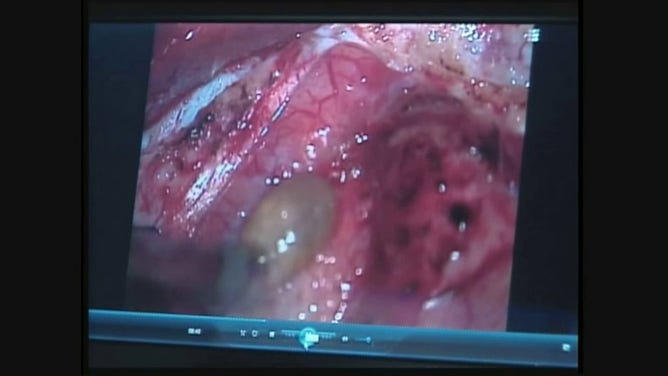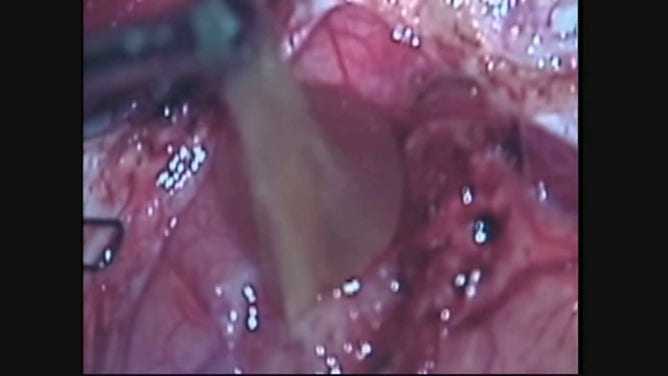Rare brain worms infect family after they ate undercooked bear meat, CDC says
Nine family members shared a meal of grilled bear meat. Brain worms infected six of the family, including two who only ate the veggies from the grill.
Phoenix doctor finds brain worm not tumor
In 2009, FOX 10's Kari Lake caught up with Rosemary Alvarez who is recovering after brain surgery. Her doctor, Peter Nakaji, thought he would be removing a brain tumor but pulled out the wiggling worm. Alvarez describes her symptoms and Dr. Monica Mircesu explains how to lower risk of being infected.
A family reunion in South Dakota infected six members with brain worms – a condition called trichinellosis.
"Trichinellosis is rarely reported in the United States," wrote the Centers for Disease Control and Prevention. "As a result of changes in pork production practices from historical norms that fostered transmission, most cases reported in recent years are attributed to consumption of meat from wild game."
The CDC recently released findings of its investigation into the May 2022 larval brain infections.
Nine family members, from 12 to 62 years old, gathered at a relative's home in South Dakota. The homeowner had recently returned from a Canadian hunting trip, and brought back an American black bear.
PARASITIC WORM THAT CAN ENTER BRAIN FOUND IN ATLANTA, RESEARCHERS SAY

A) Larvae in the bear meat under a microscope. B-D) Larvae under a microsope.
(Division of Parasitic Diseases and Malaria, Center for Global Health, CDC / FOX Weather)
The Saskatchewan hunting outfitter recommended that he freeze the meat to kill parasites. He did, for 45 days.
The family told the CDC that grilling the bear meat kebabs was challenging because it was so dark, the cook couldn't tell if it was done. When they bit into it, they realized it was undercooked and put it back on the grill.
One of the family members, a 29-year-old man from Minnesota, was hospitalized with fever, severe muscle pain and swelling around the eyes. This was his second hospital stay and fourth doctor visit in 17 days. He told the medical staff about eating bear meat and that is when doctors discovered the parasitic roundworm in his body.
The CDC questioned the rest of the family spread across Minnesota, Arizona and South Dakota and found that six of them also were infected. Two of them said they only ate the vegetables that were cooked along with the meat, but scientists were not surprised.
DEADLY BRAIN-EATING AMOEBA FOUND IN IOWA BEACH AS TEMPERATURES RISE

File: Black bear meat in an Alaska kitchen.
(Jean-Erick PASQUIER/Gamma-Rapho / FOX Weather)
"As demonstrated in this outbreak, the color of meat is not a good indicator of cooking adequacy," wrote the CDC. "Safe handling of raw meat (i.e., separating raw or undercooked meat and its juices from other foods) is recommended to prevent trichinellosis; this investigation and previous investigations suggest that Trichinella-infected meat can cross-contaminate other foods."
When tested after four months in a home freezer, the bear meat was still teaming with viable larvae, more than 800 per 0.03 ounces.
"Although freezing kills Trichinella species commonly implicated in pork-associated outbreaks, freeze-resistant Trichinella species predominate in Arctic and sub-Arctic regions," the CDC reported. "Persons who consume game meat, especially that harvested in northern latitudes, should be informed that adequate cooking is the only reliable way to kill Trichinella parasites. Cooking wild game meat to an internal temperature of ≥165°F is recommended by public health authorities."
In all, four family members were hospitalized and treated. The infection cleared in the other two sickened family members without medicine.
Rare diagnosis
The CDC investigated seven outbreaks across the U.S. between January 2016 and December 2022. Scientists suspected or confirmed that bear meat was the source of the infection for the majority of the 35 people.
PARASITIC WORMS FOUND ACROSS US PARKS PUT KIDS, PET OWNERS AT RISK

File: Bear salami at a roadside stall in Romania.
(Giovanni Mereghetti/UCG/Universal Images Group / Getty Images)
Research shows that between 1% and 25% of black bears across Canada and Alaska are infected, according to the CDC. Infection rates are even higher among pure carnivores like polar bears, wolverines and cougars. The bear muscle had an exceptionally high parasite density.
Homemade jerky and sausage made from wild game can also be a source of infection.
There are only about 15 confirmed cases of trichinellosis in the U.S. every year. Worldwide there are about 10,000 recorded cases each year, according to the CDC. Even just tasting a small amount of infected meat puts a person at risk. .
Worm looked like tumor in one Arizona case
A case in Arizona left a woman without the ability to walk.
"I thought I had the flu," the woman told FOX 10 in Phoenix. "I started feeling tired, but, I started feeling numbness in my left arm, blurred vision. I'm still smiling for my kids, but now I can't get out of bed," Rosemarie Alvarez said.
An MRI showed a tumor on her brain stem, one of the most difficult places to perform surgery according to her neurosurgeon.

Brain MRIs show what looks like a brain tumor but is actually the worm.
(FOX 10)
"Here's the lump. And at this point, it still looks like a brain tumor. And so we're just opening up to see inside," Dr. Peter Nakaji said, showing the reporter a video of the operation. " So you can see here just sort of sucking some of the interior out."
NOT FROM A HORROR FILM: WHEN INSECTS TURN INTO ZOMBIES
Alvarez recovered after the parasite was removed, but she had to relearn to walk after the brain surgery.
She has no idea where she ingested the larvae, which could have been growing for weeks or even years, according to her doctors.
Her infection came from a tapeworm parasite. Tapeworms lay thousands of eggs in the stomach of an infected animal or person. The eggs are released when the infected person or animal uses the bathroom. Once ingested, the eggs grow and make their way into the bloodstream and sometimes the brain.

File: This micrograph reveals a developing Trichinella cyst within human skeletal muscle tissue. After exposure to gastric acid and pepsin, the larvae are released from the cysts and invade the small bowel mucosa where they develop into adult worms. After 1 week, the females release larvae that migrate to the striated muscles where they form cysts.
( BSIP/UIG / Getty Images)
Nakaji feels she got it from someone handling her food before she ate it.
"When somebody who's affected doesn't have good hygiene, their hands touch what we eat," Nakaji said. Those eggs go into our body. They grow up into this tapeworm that can grow."
Medicine is the best treatment for trichinellosis. For prevention, always cook wild game to an interior temperature of 165 degrees. Be careful about eating in foreign countries, and always wash your hands after using the bathroom or touching raw meat.


